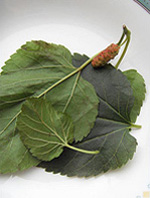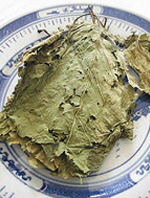|
 |
| Fresh mulberry leaf |
| |
 |
| Dried mulberry leaf |
|
| Name |
Latin Name: Folium Mori
Common Name: Mulberry leaf
Scientific Name: Morus alba L.
Chinese Name: ®á¸
Pinyin Name: sang ye |
| Top |
|
| Origin |
|
Mulberry leaf belongs to Morus alba L., a small deciduous arbor tree of the Moraceae family. Clinically, it is used either in dried or processed (fried with honey) forms.[1],[2] |
| Top |
|
| Where Does It Grow? |
| Mulberry leaf is widely distributed in China. Nowadays, it is mainly supplied by cultivation, and produced in provinces like Zhejiang, Jiangsu, Anhui, Hunan, Sichuan and Guangdong.[1],[5] |
| Top |
| Nature and Flavor |
| Mulberry leaf is cold in nature, sweet and bitter in flavor, and mainly manifests its therapeutic actions in the lung and liver meridians.[2] |
| Top |
|
| Identified Active Components/ Major Chemical Constituents |
Mulberry leaf has complex components, and the main active components are sterols, flavonoids, volatile oils, coumarins and alkaloids. The sterols include inokosterone, ecdysterone, stigmasterol, campesterol, lupeol,£]-sitosterol, myoinositol and £]-amyrin. The flavonoids include rutin, quercetin, isoquercitrin, moracetin kuwanon, kaempferol-3-O-£]-D-glucopyranoside, and astragalin. The coumarins include bergaten, umbelliferone, scopoletin, scopolin, hydroxycoumarin. The volatile oils include acetic acid, propionicacid, butyric acid, isobutyric acid, valericacid, isovaleric acid, caproic acid, methyl salicylate, guaiacol, ortho cresol, m-cresol, p-cresol, and eugenol. Other ingredients are organic acids like chlorogenic acid, fumaric acid, palmitic acid, ethylpalmitate, folic acid, and folinic acid; polysaccharides, amino acids, vitamins and multiple minerals.[4],[5],[6],[7]
In the Pharmacopoeia of People's Republic of China (2010 Edition) - Part I, the level of rutin should not less than 0.10%, as the standard quality of mulberry leaf. |
| Top |
|
| Drug actions in TCM |
| Mulberry leaf dispels wind, clears heat, moistens lung, soothes liver and promotes eye health.[2] |
| Top |
|
| Traditional Uses in TCM |
|
Mulberry leaf is often used in early stage of feverish conditions that accompany with headache, sweating, aversion to wind blowing, coughing or chest pain; other conditions like dry coughing, throat and mouth dryness, painful and swollen eyes, blurred vision, dizziness, hives and swollen legs are also indicated.[2],[3],[4]
- Mulberry leaf is good at dispelling wind and clearing heat
In the early stage of upper respiratory infections, when individuals occur mild fever, headache, sweating, aversion to wind blowing, coughing, throat soreness, and mouth dryness, mulberry leaf can work with herbs like chrysanthemum, weeping forsythia capsule, peppermint, platycodon root, great burdock fruit and hogfennel root to dispel wind evils and clear heat evils in the superficial portion of the body for relief.
- Mulberry leaf moistens lung system
When the lung is attacked by wind-heat or dryness evils, there will be dry coughing, mouth dryness, little and sticky sputum or blood-tinged sputum. Mulberry leaf can work with schizonepeta herb, coastal glehnia root, dwarf lily-turf tuber, unibract fritillary bulb and bitter apricot seed to lubricate the lung. A well-known prescription for that is Mulberry and Apricot Decoction.
- Mulberry leaf is commonly used in eye problems
When wind and heat evils attacking the liver meridian, the eyes can be red, sensitive to light, and teary, mulberry leaf can be decocted alone for eye washing, at the same time, it is also decocted with chrysanthemum, horsetail and caltrop fruit for oral administration. When excess fire accumulated in the liver meridian, there can be red and painful eyes, headache and dizziness, mulberry leaf can work with herbs like cassia seed, selfheal fruit spike, chrysanthemum, and plantain seed to soothe the liver and clear the fire for relief. Liver and kidney deficiencies lead to blurred and dim visions, mulberry leaf can be combined with glossy privet fruit, wolfberry fruit, black sesame and honey to make pills for long term consumption, which nourishes the liver and kidney.
- Mulberry leaf stops bleeding
Bleeding symptoms such as nosebleeds are usually associated with an over-heated blood, mulberry leaf alone or with other herbs can be selected to cool down the blood and stop bleeding.
Modern TCM also uses mulberry leaf to treat conjunctivitis, keratitis, lower limbs swelling, hypertension and skin rashes. |
| Top |
|
| Pharmacological Actions |
|
Studies have showed that mulberry leaf has effects in anti-inflammatory, lowering body temperature, reducing blood sugar, protecting skin, anti-septic, and reducing blood pressure and lipids.[4],[7],[8] |
| Top |
| Toxicology |
| 10% injection solution of mulberry leaf is given once to mice (body weight 20g) abdominally, the safe dose amount is equivalent to 250 times that used in human. A dose that is equivalent to 60 times of the human usage does is given to mice abdominally, when injected for 21 days continuously, no damages had found in the liver, kidneys and lungs. However, when the dose further increased, the above organs appeared degenerations and bleeding.[4] |
| Top |
|
| Administration and Dosage |
For decoction, the usual dose of mulberry leaf is 6¡ã12g, and can be higher to 16¡ã60g if necessary. Mulberry leaf is also ground to make pills or powder form for oral administration. The herb can be decocted for washing or pounded for topical dressing.[2],[4]
When mulberry leaf is processed with honey, its effects on moistening lung and arresting the coughing will be enhanced, therefore processed mulberry leaf is often selected to treat dry coughing.[2],[4] |
| Top |
|
| Adverse Effect, Side Effects and Cautions |
| Clinical demonstrations show no adverse response when decocting within the suggested does, even for long term consumption or in high does (below 60g) is unlikely to develop obvious adverse responses.[4] |
| Top |
|
| References |
| 1. |
Li Jiashi (editor-in-chief), Chinese Medicine Identification, Shanghai Scientific and Technical Publishers, 2000-2. |
|
|
| 2. |
Lui Daiquan (editor-in-chief), Chinese Herbal Medicine, Shanghai Scientific and Technical Publishers, 2000-6. |
|
|
| 3. |
Tao Yufeng, Clinical Herbal Medicine, People¡¦s Medical Publishing House, 2005-5. |
|
|
| 4. |
Chen Pian, Clinical Application of Tonifying Herbs, Second Military Medical University Press, 2008-8. |
|
|
| 5. |
Zhao Zhongzhen & Xiao Peigen (editor-in-chief), Contemporary Medicinal Herbal Glossary, Hong Kong Jockey Club Institute of Chinese Medicine, 2006-8. |
|
|
| 6. |
Nanjing University of Chinese Medicine (edited), Materia Medica, Shanghai Scientific and Technical Publishers, 2005-5. |
|
|
| 7. |
http://www.zysj.com.cn/zhongyaocai/yaocai_s/sangye.html |
|
|
| 8. |
http://baike.baidu.com/view/37610.htm?fr=aladdin |
|
| Top |
|
|
|
|